
Corpo e Som
Uma Exploração Visual da Série Harmônica
Podcast: Corpo e Som - Análise Visual da Série Harmônica
Ouça a discussão completa sobre a análise visual da série harmônica e sua relação com o corpo humano.
Listen to the full discussion about the visual analysis of the harmonic series and its relationship with the human body.
Análise Profunda das Imagens: Corpo e Som
Este estudo analisa a série de imagens criadas pelo Prof. Jack Lima em 30/04/2019, que exploram a relação entre a Série Harmônica, o corpo humano e o som. Esta abordagem transdisciplinar integra elementos de teoria musical, acústica, anatomia e artes visuais de maneira inovadora, oferecendo uma perspectiva única sobre os 16 primeiros sons da série harmônica através de padrões geométricos e codificação por cores.
Imagem 1: Padrão Triangular da Série Harmônica

Esta imagem exibe um diagrama que lembra uma pauta musical com linhas horizontais. Sobre essas linhas, há uma disposição de círculos coloridos interligados por linhas verticais e curvas, formando uma estrutura em forma de leque ou cascata que se expande para os lados a partir de um ponto central inferior. As cores dos círculos variam, incluindo vermelho, laranja, amarelo, verde, azul, roxo e cinza. A organização segue um padrão simétrico que parece mapear as relações matemáticas entre os sobretons na série harmônica, com cada linha horizontal potencialmente representando diferentes patamares da série.
Imagem 2: Padrão Triangular com Linha Vertical
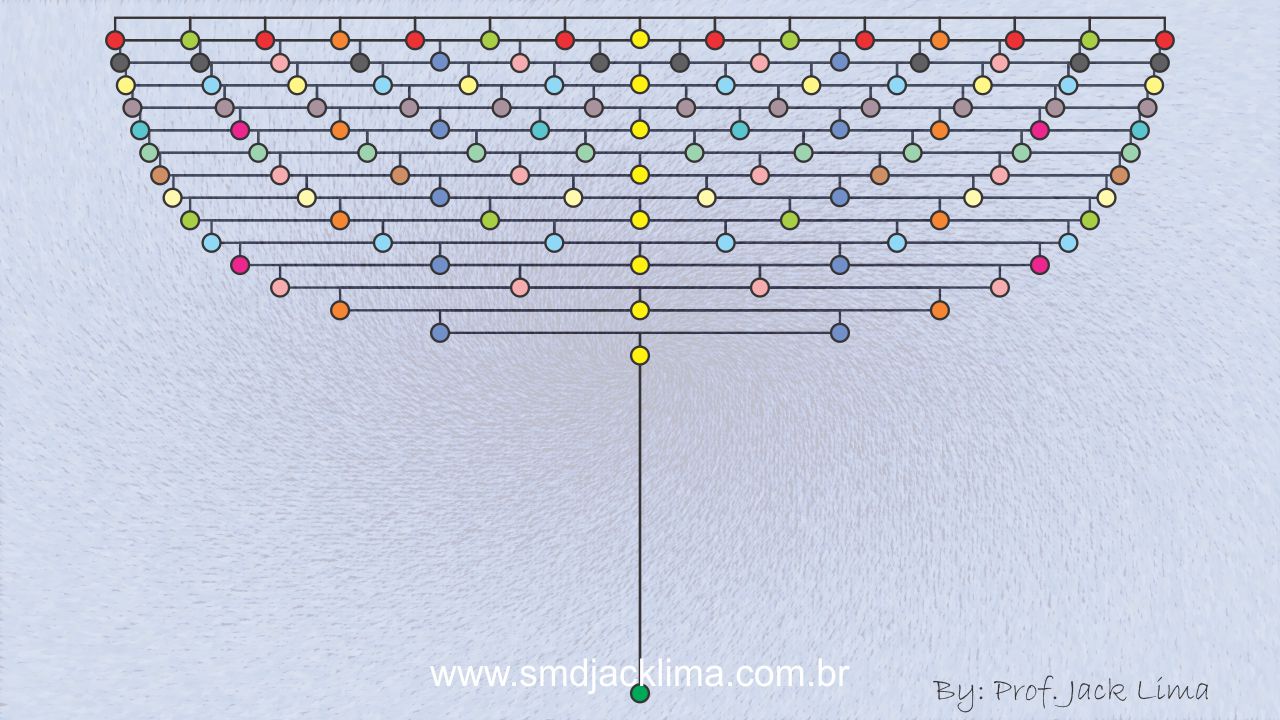
Similar à Imagem 1, esta representação apresenta o mesmo tipo de diagrama com linhas horizontais e círculos coloridos interligados. A diferença visual principal é a linha vertical central que se estende para baixo a partir do ponto central inferior da estrutura em leque. Esta linha vertical pode simbolizar a relação fundamental entre os harmônicos, estabelecendo uma conexão direta entre a fundamental (na base) e os harmônicos superiores, reforçando a ideia de que todos os harmônicos derivam desta fundamental.
Imagem 3: Figura Humana Estilizada em Blocos
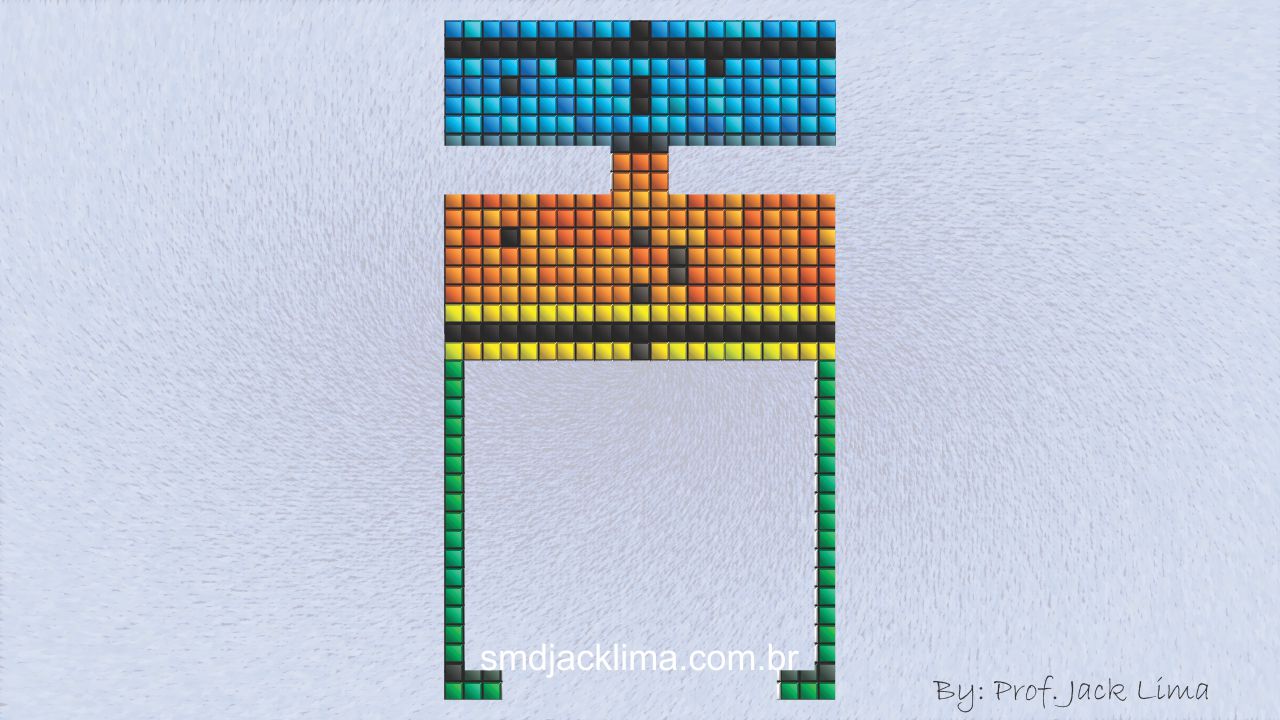
Esta imagem mostra uma representação visual que se assemelha a uma figura humana estilizada, construída a partir de blocos coloridos de formato quadrado e retangular. As cores predominantes são azul na parte superior (cabeça/tronco superior), laranja na parte central (tronco) e verde nas partes inferiores (pernas/base). Há também detalhes em preto e amarelo na região central. Esta estrutura em grid com codificação por cores (azul, laranja, amarelo e verde) forma um padrão em "T" que possivelmente relaciona as frequências ou qualidades tonais entre diferentes sobretons, usando o posicionamento espacial para mostrar como os diferentes harmônicos se relacionam entre si.
Imagem 4: Relação entre Instrumento Musical e Corpo
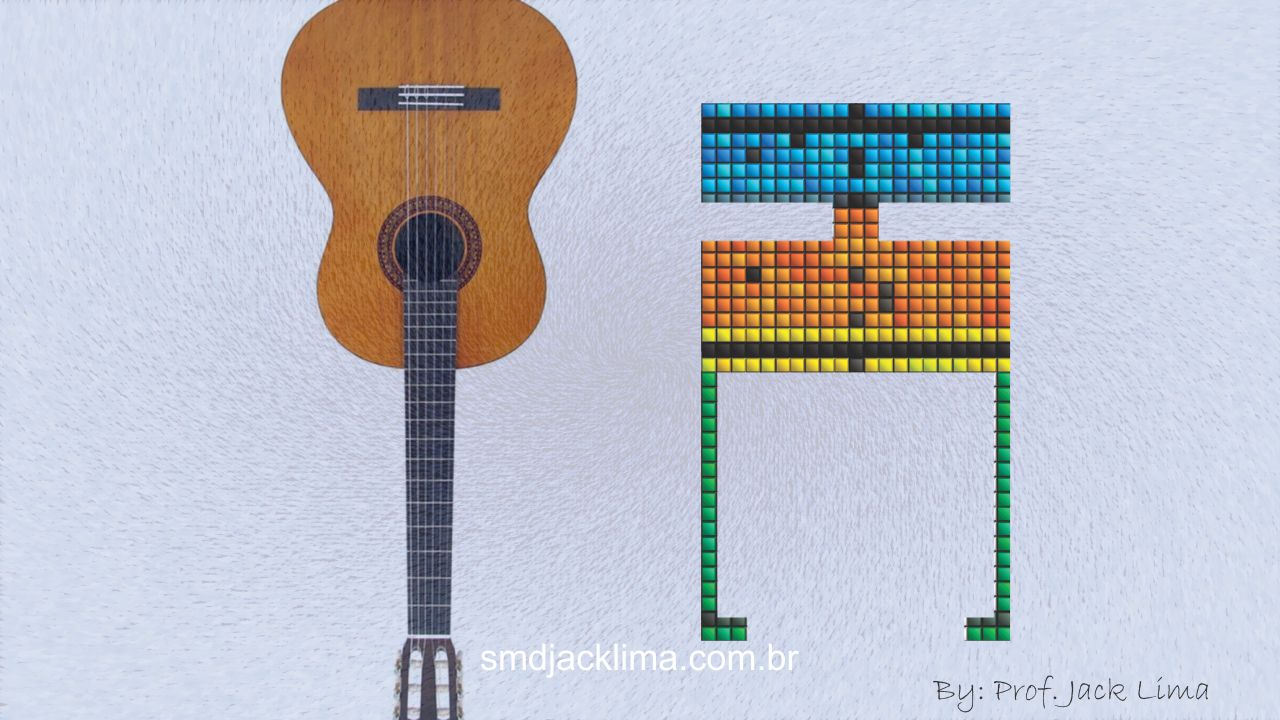
A Imagem 4 combina dois elementos visuais: à esquerda, a fotografia de um violão clássico; à direita, a mesma figura estilizada em blocos coloridos apresentada na Imagem 3. Esta justaposição estabelece uma conexão visual entre o instrumento musical (produtor de sons e, consequentemente, de harmônicos) e a representação estilizada do corpo humano, sugerindo uma relação íntima entre a estrutura da série harmônica, os instrumentos musicais e o corpo humano como receptor e intérprete dos sons.
Imagem 5: Sobreposição da Estrutura Harmônica ao Corpo
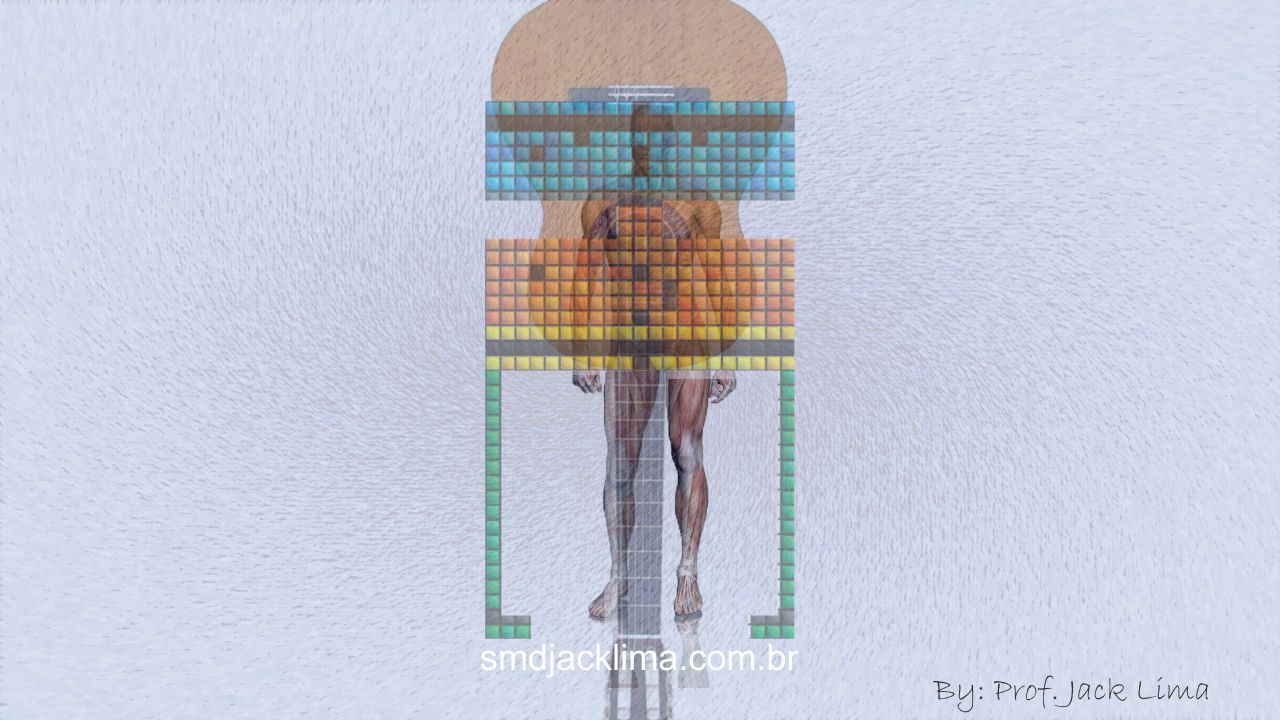
Esta imagem sobrepõe a figura estilizada em blocos coloridos (vista nas Imagens 3 e 4) sobre uma imagem de pernas humanas. A figura de blocos coloridos está posicionada na parte superior da imagem, alinhada com a região do tronco e pélvis de uma figura humana que aparece da cintura para baixo, mostrando as pernas e pés. Esta sobreposição reforça a aparente relação entre a estrutura de blocos (que representa a série harmônica) e o corpo humano, sugerindo que a série harmônica pode ser compreendida não apenas como um fenômeno acústico, mas também como algo que tem correspondência com a estrutura corporal humana.
Imagem 6: Dualidade Rítmica - Som e Silêncio

A Imagem 6 apresenta duas figuras humanas em 3D, de corpo inteiro, com a musculatura aparente. Uma figura, aparentemente masculina, é rotulada como "Positivo", enquanto a outra, aparentemente feminina, é rotulada como "Negativa". Ambas as figuras estão em uma pose frontal e simétrica. Esta representação explora especificamente a dualidade fundamental presente no ritmo musical, onde o elemento "positivo" (figura masculina) simboliza os sons ou notas musicais, enquanto o elemento "negativo" (figura feminina) representa as pausas ou silêncios. Esta dualidade é essencial para a construção rítmica em música, pois o ritmo existe precisamente nesta alternância entre presença e ausência de som, entre ação e descanso, entre som e silêncio.
Imagem 7: Gênese da Música - Ritmo e Procriação
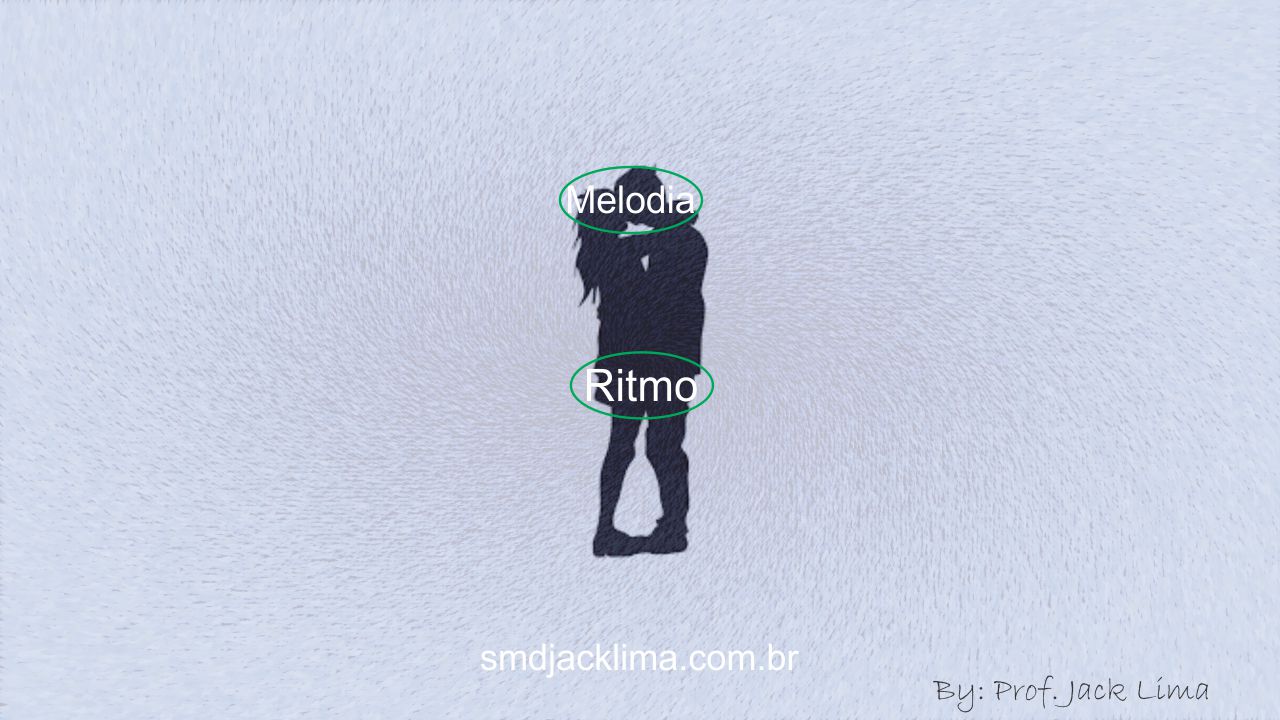
Esta imagem mostra uma silhueta escura de uma pessoa de pé. Sobreposta à silhueta, há duas elipses verdes contendo texto: "Melodia" posicionada mais acima, na altura da cabeça/tronco superior, e "Ritmo" posicionada mais abaixo, na altura do tronco/quadril. Esta representação estabelece uma profunda analogia entre a criação musical e a reprodução humana. O posicionamento do "Ritmo" na região pélvica faz alusão ao ato sexual, sugerindo que assim como os seres humanos são concebidos através do ritmo do ato reprodutivo, a música também nasce primordialmente da combinação entre ritmo e notas (melodia). Esta analogia reforça a ideia do ritmo como elemento fundacional e gerador, tanto na procriação humana quanto na criação musical, estabelecendo um paralelo entre processos biológicos e artísticos de criação.
Imagem 8: Padrão de "Parede de Tijolos"
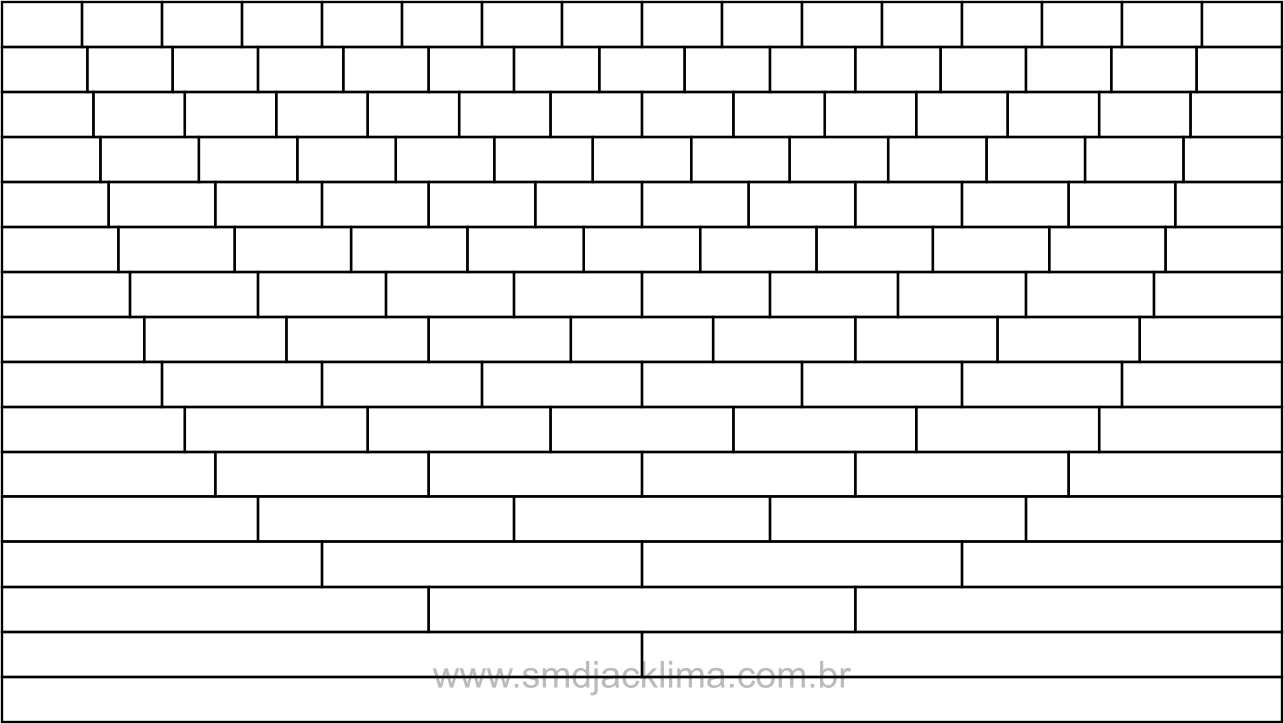
A Imagem 8 é um diagrama em preto e branco composto por uma série de retângulos de tamanhos variados dispostos em linhas horizontais. Os retângulos na parte superior são menores e parecem ir aumentando de tamanho nas linhas inferiores. A disposição dos blocos forma uma espécie de pirâmide invertida ou estrutura escalonada. Esta representação demonstra visualmente como os comprimentos de onda se relacionam na série harmônica - mais curtos nas frequências mais altas (harmônicos superiores) e mais longos nas frequências mais baixas (fundamental e primeiros harmônicos). É uma visualização direta da relação matemática entre o comprimento de onda e a frequência na série harmônica.
Conceito Integrado: Corpo e Som
A análise das oito imagens revela que o trabalho do Prof. Jack Lima vai além de uma simples visualização da série harmônica - é uma exploração transdisciplinar das relações entre os sons da série harmônica e o corpo humano como veículo de expressão e percepção musical. As imagens estabelecem conexões visuais entre:
- A estrutura matemática da série harmônica (Imagens 1, 2 e 8)
- Uma representação estilizada do corpo humano usando blocos coloridos (Imagem 3)
- A relação entre instrumentos musicais e o corpo (Imagem 4)
- A sobreposição da representação da série harmônica ao corpo humano (Imagem 5)
- A dualidade inerente às ondas sonoras e às estruturas musicais (Imagem 6)
- A localização de elementos musicais fundamentais (melodia e ritmo) em diferentes regiões do corpo (Imagem 7)
Juntas, estas imagens sugerem um sistema integrado onde a série harmônica não é apenas um fenômeno acústico ou musical abstrato, mas algo que tem correspondências diretas com a estrutura e as funções do corpo humano.
Originalidade
Com base na pesquisa realizada, não foram encontradas representações visuais que utilizem exatamente a mesma abordagem do Prof. Lima, combinando padrões geométricos, codificação por cores e múltiplas perspectivas visuais da série harmônica com uma representação integrada do corpo humano. Embora existam muitas visualizações da série harmônica, tanto como representações lineares quanto logarítmicas de frequências, bem como em formas de espectrogramas e modelos 3D, a abordagem específica apresentada nestas imagens parece ser original.
A originalidade do trabalho do Prof. Lima reside na integração de diferentes domínios do conhecimento - teoria musical, acústica, anatomia e artes visuais - através de uma linguagem visual distintiva que conecta explicitamente a série harmônica ao corpo humano. Esta abordagem oferece insights potencialmente valiosos sobre como a música pode ser compreendida não apenas como um fenômeno sonoro, mas como uma experiência corporal integrada.
Conclusão
As representações visuais criadas pelo Prof. Jack Lima constituem uma contribuição original e valiosa para o campo da teoria musical e acústica, oferecendo uma perspectiva integrada sobre a relação entre a série harmônica e o corpo humano. Ao combinar elementos geométricos, codificação por cores e múltiplas abordagens visuais, estas imagens estabelecem uma ponte visual entre os domínios abstratos da matemática musical e as experiências concretas do corpo.
O conjunto de imagens sugere um modelo conceitual onde a série harmônica tem correspondências estruturais e funcionais com o corpo humano, oferecendo novas maneiras de compreender e explorar as complexas relações matemáticas e musicais presentes na série harmônica. A abordagem do Prof. Lima destaca-se por sua originalidade e potencial para aplicações educacionais, criativas e científicas no estudo integrado da música e do corpo humano.
Referências
- Lima, J. (2019). Corpo e Som: Visualização da Série Harmônica. Brasil: SMD Jack Lima.
- Série harmônica (música). (2025, Janeiro 14). Wikipedia.
- Neff, C. A série harmônica. Becky Dell Music Academy.
- A série harmônica e suas implicações na composição. ZOT Zin Guitar Lessons.
- Harmonic Series - structure, application and background. Oberton.org.
Deep Analysis of the Images: Body and Sound
This study analyzes the series of images created by Prof. Jack Lima on 04/30/2019, which explore the relationship between the Harmonic Series, the human body, and sound. This transdisciplinary approach integrates elements of music theory, acoustics, anatomy, and visual arts in an innovative way, offering a unique perspective on the first 16 sounds of the harmonic series through geometric patterns and color coding.
Image 1: Triangular Pattern of the Harmonic Series

This image displays a diagram resembling a musical staff with horizontal lines. On these lines, there is an arrangement of colored circles interconnected by vertical and curved lines, forming a fan-like or cascading structure that expands outwards from a central lower point. The colors of the circles vary, including red, orange, yellow, green, blue, purple, and gray. The organization follows a symmetrical pattern that appears to map the mathematical relationships between overtones in the harmonic series, with each horizontal line potentially representing different tiers of the series.
Image 2: Triangular Pattern with Vertical Line

Similar to Image 1, this representation presents the same type of diagram with horizontal lines and interconnected colored circles. The main visual difference is the central vertical line extending downwards from the central lower point of the fan structure. This vertical line may symbolize the fundamental relationship between harmonics, establishing a direct connection between the fundamental (at the base) and the upper harmonics, reinforcing the idea that all harmonics derive from this fundamental.
Image 3: Stylized Human Figure in Blocks

This image shows a visual representation resembling a stylized human figure, constructed from colored blocks of square and rectangular shapes. The predominant colors are blue in the upper part (head/upper torso), orange in the central part (torso), and green in the lower parts (legs/base). There are also black and yellow details in the central region. This grid structure with color coding (blue, orange, yellow, and green) forms a "T" pattern that possibly relates frequencies or tonal qualities between different overtones, using spatial positioning to show how different harmonics relate to each other.
Image 4: Relationship Between Musical Instrument and Body

Image 4 combines two visual elements: on the left, a photograph of a classical guitar; on the right, the same stylized colored block figure presented in Image 3. This juxtaposition establishes a visual connection between the musical instrument (producer of sounds and, consequently, of harmonics) and the stylized representation of the human body, suggesting an intimate relationship between the structure of the harmonic series, musical instruments, and the human body as a receiver and interpreter of sounds.
Image 5: Superimposition of Harmonic Structure on the Body

This image superimposes the stylized colored block figure (seen in Images 3 and 4) onto an image of human legs. The colored block figure is positioned in the upper part of the image, aligned with the torso and pelvic region of a human figure shown from the waist down, displaying the legs and feet. This superposition reinforces the apparent relationship between the block structure (representing the harmonic series) and the human body, suggesting that the harmonic series can be understood not only as an acoustic phenomenon but also as something that corresponds to the human body structure.
Image 6: Rhythmic Duality - Sound and Silence

Image 6 presents two full-body 3D human figures with visible musculature. One figure, apparently male, is labeled "Positivo" (Positive), while the other, apparently female, is labeled "Negativa" (Negative). Both figures are in a frontal and symmetrical pose. This representation specifically explores the fundamental duality present in musical rhythm, where the "positive" element (male figure) symbolizes the sounds or musical notes, while the "negative" element (female figure) represents the rests or silences. This duality is essential for rhythmic construction in music, as rhythm exists precisely in this alternation between presence and absence of sound, between action and rest, between sound and silence.
Image 7: Genesis of Music - Rhythm and Procreation

This image shows a dark silhouette of a standing person. Superimposed on the silhouette are two green ellipses containing text: "Melodia" (Melody) positioned higher up, at the head/upper torso level, and "Ritmo" (Rhythm) positioned lower down, at the torso/hip level. This representation establishes a profound analogy between musical creation and human reproduction. The positioning of "Rhythm" in the pelvic region alludes to the sexual act, suggesting that just as humans are conceived through the rhythm of the reproductive act, music also primarily arises from the combination of rhythm and notes (melody). This analogy reinforces the idea of rhythm as a foundational and generative element, both in human procreation and in musical creation, establishing a parallel between biological and artistic creation processes.
Image 8: "Brick Wall" Pattern

Image 8 is a black and white diagram composed of a series of rectangles of varying sizes arranged in horizontal rows. The rectangles in the upper part are smaller and seem to increase in size in the lower rows. The arrangement of the blocks forms a kind of inverted pyramid or stepped structure. This representation visually demonstrates how wavelengths relate in the harmonic series - shorter at higher frequencies (upper harmonics) and longer at lower frequencies (fundamental and first harmonics). It is a direct visualization of the mathematical relationship between wavelength and frequency in the harmonic series.
Integrated Concept: Body and Sound
The analysis of the eight images reveals that Prof. Jack Lima's work goes beyond a simple visualization of the harmonic series - it is a transdisciplinary exploration of the relationships between the sounds of the harmonic series and the human body as a vehicle for musical expression and perception. The images establish visual connections between:
- The mathematical structure of the harmonic series (Images 1, 2, and 8)
- A stylized representation of the human body using colored blocks (Image 3)
- The relationship between musical instruments and the body (Image 4)
- The superimposition of the harmonic series representation on the human body (Image 5)
- The inherent duality in sound waves and musical structures (Image 6)
- The location of fundamental musical elements (melody and rhythm) in different regions of the body (Image 7)
Together, these images suggest an integrated system where the harmonic series is not just an abstract acoustic or musical phenomenon, but something that has direct correspondences with the structure and functions of the human body.
Originality
Based on the research conducted, no visual representations were found that utilize exactly the same approach as Prof. Lima, combining geometric patterns, color coding, and multiple visual perspectives of the harmonic series with an integrated representation of the human body. Although there are many visualizations of the harmonic series, both as linear and logarithmic representations of frequencies, as well as in the forms of spectrograms and 3D models, the specific approach presented in these images appears to be original.
The originality of Prof. Lima's work lies in the integration of different domains of knowledge - music theory, acoustics, anatomy, and visual arts - through a distinctive visual language that explicitly connects the harmonic series to the human body. This approach offers potentially valuable insights into how music can be understood not just as a sonic phenomenon, but as an integrated bodily experience.
Conclusion
The visual representations created by Prof. Jack Lima constitute an original and valuable contribution to the field of music theory and acoustics, offering an integrated perspective on the relationship between the harmonic series and the human body. By combining geometric elements, color coding, and multiple visual approaches, these images establish a visual bridge between the abstract domains of musical mathematics and the concrete experiences of the body.
The set of images suggests a conceptual model where the harmonic series has structural and functional correspondences with the human body, offering new ways to understand and explore the complex mathematical and musical relationships present in the harmonic series. Prof. Lima's approach stands out for its originality and potential for educational, creative, and scientific applications in the integrated study of music and the human body.
References
- Lima, J. (2019). Body and Sound: Harmonic Series Visualization. Brazil: SMD Jack Lima.
- Harmonic series (music). (2025, January 14). Wikipedia.
- Neff, C. The Harmonic Series. Becky Dell Music Academy.
- The Harmonic Series and Its Implications On Composition. ZOT Zin Guitar Lessons.
- Harmonic Series - structure, application and background. Oberton.org.